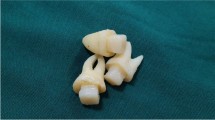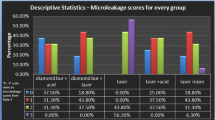Abstract
The purpose of this study was to evaluate the thickness and qualitative characteristics of the hybrid layer after two cavity preparation methods, using Er:YAG laser in QSP mode and conventional carbide burs. Additionally, two different adhesive techniques were investigated using etch-and-rinse and self-etch adhesive systems. Sixty sound human third molars were used and were randomly divided into four groups (n = 15). In the first two groups, large (4 mm length, 3 mm wide, and 3 mm deep) class I cavities were prepared using Er:YAG laser (2.94 μm) in QSP mode, while in the other two groups, the cavities were prepared using carbide burs. After cavity preparations, two different adhesive techniques with GLUMA® 2 Bond (etch-and-rinse) and Clearfil™ Universal Bond Quick (self-etch) were applied. For the qualitative evaluation of the formed hybrid layer, photomicrographs were taken using SEM, and elemental semi-quantitative analysis was performed using EDS to confirm the extent of the hybrid layer. One-way ANOVA was applied to verify the existence of statistically significant differences, followed by Tukey test for post hoc comparisons (Bonferroni corrected), and the level of significance was set at a = 0.05. The laser-treated groups exhibited higher hybrid layer thickness than bur-treated groups (p < 0.001). Between the laser-treated groups, etch-and-rinse technique presented higher hybrid layer thickness than self-etch technique (p < 0.001), while between the bur-treated groups, no significant differences were detected (p = 0.366). Er:YAG laser cavity preparations in QSP mode may be advantageous for adhesion of composite restorations, but more data are necessary to confirm its clinical effectiveness.





Similar content being viewed by others
References
Nakabayashi N, Kojima K, Masuhara E (1982) The promotion of adhesion by the infiltration of monomers into tooth substances. J Biomed Mater Res 16:265–273
Breschi L, Mazzoni A, Ruggeri A, Cadenaro M, Di Lenarda R, De Stefano DE (2008) Dental adhesion review: aging and stability of the bonded interface. Dent Mater 24:90–101
Hashimoto M, Tay FR, Ohno H, Sano H, Kaga M, Yiu C et al (2003) SEM and TEM analysis of water degradation of human dentinal collagen. J Biomed Mater Res B Appl Biomater 66:287–298
Hashimoto M, Ohno H, Sano H, Tay FR, Kaga M, Kudou Y et al (2002) Micromorphological changes in resin-dentin bonds after 1 year of water storage. J Biomed Mater Res 63:306–311
Akin GE, Herguner-Siso S, Ozcan M, Ozel-Bektas O, Akin H (2012) Bond strengths of one-step self-etch adhesives to laser irradiated and bur-cut dentin after water storage and thermocycling. Photomed Laser Surg 30:214–221
Nakabayashi N, Nakamura M, Yasuda N (1991) Hybrid layer as a dentin-bonding mechanism. J Esthet Dent 3:133–138
Nakabayashi N, Saimi Y (1996) Bonding to intact dentin. J Dent Res 75:1706–1715
Breschi L, Mazzoni A, Ruggeri A, Cadenaro M, Di Lenarda R, De Stefano DE (2008) Dental adhesion review: aging and stability of the bonded interface. Dent Mater 24:90–101
Van Meerbeek D, De Munck J, Yoshida Y, Inoue S, Vargas M, Vijay P et al (2003) Adhesion to enamel and dentin: current status and future challenges. Oper Dent 28:215–235
Cavalcanti AN, Pilecki P, Foxton RM, Watson TF, Oliveira MT, Gianinni M et al (2009) Evaluation of the surface roughness and morphologic features of Y-TZP ceramics after different surface treatments. Photomed Laser Surg 27:473–479
Esteves-Oliveira M, Carvalho WL, de Paula Eduardo C, Zezell DM (2008) Influence of the additional Er:YAG laser conditioning step on the microleakage of class V restorations. J Biomed Mater ResB Appl Biomater 87:538–543
Ramos TM, Ramos-Oliveira TM, Moretto SG, de Freitas PM, Esteves-Oliveira M, de Paula Eduardo C (2014) Microtensile bond strength analysis of adhesive systems to Er:YAG and Er,Cr:YSGG laser-treated dentin. Lasers Med Sci 29:565–573
Harashima T, Kinoshita J, Kimura Y, Brugnera A, Zanin F, Pecora JD et al (2005) Morphological comparative study on ablation of dental hard tissue at cavity preparation by Er:YAG and Er,Cr:YSGG lasers. Photomed Laser Surg 23:52–55
Lee BS, Lin PY, Chen MH, Hsieh TT, Lin CP, Lai JY et al (2007) Tensile bond strength of Er,Cr:YSGG laser-irradiated human dentin and analysis of dentin-resin interface. Dent Mater 23:570–578
Corona SA, de Souza AE, Chinelatti MA, Borsatto MC, Pecora JD, Palma-Dibb RG (2007) Effect of energy and pulse repetition rate of Er:YAG laser on dentin ablation ability and morphological analysis of the laser-irradiated substrate. Photomed Laser Surg 25:26–33
Yung FY, Gutknecht N, Franzen R, Fischer H (2013) Shear strength of composite bonded to Er:YAG laser-prepared enamel: an in vitro comparative study. Lasers Med Sci 28:879–889
Brulat N, Rocca JP, Leforestier E, Fiorucci G, Nammour S, Bertrand MF (2009) Shear bond strength of self-etching adhesive systems to Er:YAG-laser-prepared dentin. Lasers Med Sci 24:53–57
Ramos RP, Chimello DT, Chinelatti MA, Nonaka T, Pecora JD, Palma Dibb RG (2002) Effect of Er:YAG laser on bond strength to dentin of a self-etching primer and two single-bottle adhesive systems. Lasers Surg Med 31:164–170
Lukac N, Suhovršnik T, Lukac M, Jezeršek M (2016) Ablation characteristics of quantum square pulse mode dental erbium laser. In: J biomed optics 21:015012–1-105
Goldstein GI, Newbury DE, Echlin P, Joy DC, Fiori C, Lifshin E (1981) Scanning electron microscopy and x-ray microanalysis. Plenum Press, New York
Aranha AC, De Paula Eduardo C, Gutknecht N, Marques MM, Ramalho KM, Apel C (2007) Analysis of the interfacial micromorphology of adhesive systems in cavities prepared with Er, Cr: YSGG, Er:YAG laser and bur. Microsc Res Tech 70:745–751
Guven Y, Aktoren O (2015) Shear bond strength and ultrastructural interface analysis of different adhesive systems to Er:YAG laser-prepared dentin. Lasers Med Sci 30:769–778
Armengol V, Laboux O, Weiss P, Jean A, Hamel H (2003) Effects of Er:YAG and Nd:YAP laser irradiation on the surface roughness and free surface energy of enamel and dentin: an in vitro study. Oper Dent 28:67–74
Koliniotou-Koumpia E, Kouros P, Dionysopoulos D, Zafiriadis L (2015) Bonding strength of silorane-based composite to Er:YAG laser prepared dentin. Lasers Med Sci 30:509–516
Shahabi S, Chiniforush N, Bahramian H, Monzavi A, Baghalian A, Kharazifard MJ (2013) The effect of erbium family laser on tensile bond strength of composite to dentin in comparison with conventional method. Lasers Med Sci 28:139–142
Hossain M, Yamade Y, Nakammura K, Murakami Y, Tamaki Y, Matsumoto K (2003) A study on surface roughness and microleakage test in cavities prepared by Er:YAG laser irradiation and etched bur cavities. Lasers Med Sci 18:25–31
Kataumi M, Nakajima M, Yamada T, Tagami J (1998) Tensile bond strength and SEM evaluation of Er:YAG laser irradiated dentin using dentin adhesive. Dent Mater J 17:125–138
Ceballos L, Toledano M, Osorio R, Tay F, Marshall G (2002) Bonding to Er-YAG-laser-treated dentin. J Dent Res 81:119–122
Krejci I, Schupbach P, Balmelli F, Lutz F (1999) The ultra-structure of a compomer adhesive interface in enamel and dentin and its marginal adaptation under dentinal fluid as compared to that of a composite. Dent Mater 15:349–358
Uno S, Finger WJ (1995) Function of the hybrid zone as a stress-absorbing layer in resin-dentin bonding. Quintessence Int 26:733–738
Pioch T, Stotz S, Buff E, Duschner H, Staehle HJ (1998) Influence of different etching times on hybrid layer formation and tensile bond strength. Am J Dent 11:202–206
Van Landuyt K, De Munck J, Coutinho E, Peumans M, Lambrechts P, Van Meerbeek B (2005) Smear layer and the process of hybridization. In: Eliades G, Watts DC, Eliades T (eds) Dental hard tissues and bonding interfacial phenomena and related properties. Springer, Berlin, pp 89–122
Anchieta RB, Machado LS, Sundfeld RH, Reis AF, Giannini M, Luersen MA et al (2015) Effect of partially demineralized dentin beneath the hybrid layer on dentin–adhesive interface micromechanics. J Biomechanics 48:701–707
Van Meerbeek B, De Munck J, Mattar D, Van Landuyt K, Lambrechts P (2003) Microtensile bond strengths of an etch & rinse and self-etch adhesive to enamel and dentin as a function of surface treatment. Oper Dent 28:647–660
Attrill D, Davies R, King T, Dickinson M, Blinkhorn A (2004) Thermal effects of the Er:YAG laser on a simulated dental pulp: a quantitative evaluation of the effects of a water spray. J Dent 32:35–40
Visuri SR, Gilbert JL, Wright DD, Wigdor HA, Walsh JT Jr (1996) Shear strength of composite bonded to Er:YAG laser-prepared dentin. J Dent Res 75:599–605
Kallis A, Tolidis K, Gerasimou P, Gutknecht N, Koliniotou-Koumpia E (2016) Comparative study of the restoration quality in cavities prepared with Er:YAG laser in Quantum Square pulse mode and conventional method. Int J Laser Dent 6:31–37
Vogel A, Venugopalan V (2003) Mechanisms of pulsed laser ablation of biological tissues. Chem Rev 103:577–644
Majaron B, Sustercic C, Lukac M, Skaleric U, Funduk N (1998) Heat diffusion and debris screening in Er:YAG laser ablation of hard biological tissues. Appl Phys B Lasers Opt 66:479–487
Zhegova GG, Rashkova MR, Yordanov BI (2014) Perception of pain of Er_YAG dental caries treatment in adolescents—a clinical evaluation. J IMAB 20:500–503
Gutknecht N, Lukac M, Marincek M, Perhavec TKazic M (2011) A novel quantum square pulse (QSP) mode erbium dental laser. J Laser Health Acad 2011:15–21
Inoue S, Van Meerbeek B, Abe Y, Yoshida Y, Lambrechts P, Vanherle G et al (2001) Effect of remaining dentin thickness and the use of conditioner on micro-tensile bond strength of a glass ionomer adhesive. Dent Mater 17:445–455
Hashimoto M, Ohno H, Endo K, Kaga M, Sano H, Oguchi H (2000) The effect of hybrid layer thickness on bond strength: demineralized dentin zone of the hybrid layer. Dent Mater 16:406–411
Pashley DH, Ciucchi B, Sano H, Horner JA (1993) Permeability of dentin adhesive agents. Quintessence Int 24:618–631
Albaladejo A, Osorio R, Toledano M, Ferrari M (2010) Hybrid layers of etch-and-rinse versus self-etching adhesive systems. Med Oral Patol Oral Cir Bucal 15:112–118
Tay F, Sano H, Carvalho R, Pashley E, Pashley D (2000) An ultrastructural study of the influence of acidity of self-etching primers and smear layer thickness on bonding to intact dentin. J Adhes Dent 2:83–98
Acknowledgements
The authors would like to thank Dr. Stavros Oikonomidis, Solid State Physics Division, Department of Physics, Aristotle University of Thessaloniki, for his valuable contribution to SEM observations and EDS analysis of the specimens for the purposes of this investigation.
Author information
Authors and Affiliations
Corresponding author
Ethics declarations
Conflict of interest
The authors declare that they have no conflict of interest.
Research involving human participants and/or animals
There are no human participants or animals in this study.
Informed consent
For this type of study, formal consent is not required.
Rights and permissions
About this article
Cite this article
Kallis, A., Tolidis, K., Gerasimou, P. et al. Qualitative evaluation of hybrid layer formation using Er:YAG laser in QSP mode for tooth cavity preparations. Lasers Med Sci 34, 23–34 (2019). https://doi.org/10.1007/s10103-018-2575-9
Received:
Accepted:
Published:
Issue Date:
DOI: https://doi.org/10.1007/s10103-018-2575-9




